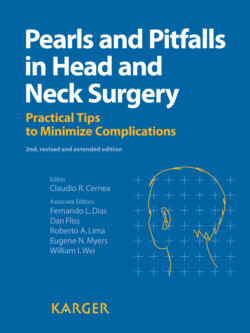Читать книгу Pearls and Pitfalls in Head and Neck Surgery - Группа авторов - Страница 10
На сайте Литреса книга снята с продажи.
ОглавлениеThyroid and Parathyroid Glands
Cernea CR, Dias FL, Fliss D, Lima RA, Myers EN, Wei WI (eds): Pearls and Pitfalls in Head and Neck Surgery. Basel, Karger, 2012, pp 8–9
DOI: 10.1159/000337948
1.4 How to Preserve the Parathyroid Glands during Thyroid Surgery
Ashok R. Shaha Vergilius José F. de Araújo Filho
Head and Neck Service, Memorial Sloan-Kettering Cancer Center, Cornell University Medical Center, New York, N.Y., USA
P E A R L S
• Incidence of temporary hypoparathyroidism is 25-30%, while the incidence of permanent hypoparathyroidism is 2-3% and depends upon certain technical modifications,such as neckdissection, paratracheal lymph node dissection (level VI), large and substernal goiters, or Hashimoto's thyroiditis.
• Parathyroid blood supply from the inferior thyroid artery, and occasionally from the superior thyroid artery or directly from the thyroid vessels. Preserve parathyroids with blood supply.
• Devascularized parathyroid should be autotrans-planted in the neck muscle. Parathyroid glands may mimic lymph nodes, thyroid tissue, or fat.
P I T F A L L S
• Symptoms of hypoparathyroidism may be subtle. However, the symptoms may become serious, especially with the development of tetany.
• Severe hypocalcemia may occur even 2-3 days after the initial surgery.
• Intravenous calcium supplement may have cardiac toxicity if given rapidly, and may irritate the skin if infiltrated.
• Large doses of oral calcium and vitamin D may lead to iatrogenic hypercalcemia.
Introduction
Since Ivor Sandstrom described parathyroid glands in humans, there has been considerable interest in their function and preservation, particularly during total thyroidectomy [1]. One of the serious complications of total thyroidectomy is temporary (25-30%) or permanent hypoparathyroidism (2-3%). The morbidity from permanent hypoparathyroidism is considerable, with a lifetime requirement of calcium and vitamin D. These small, elusive glands are crucial to sustain good health in patients undergoing total thyroidectomy. Serial calcium levels are helpful and the trending of calcium levels between 8 and 23 h is helpful. Parathormone assay has also been helpful regarding safe discharge of the patients.
Surgical Technique
Recognize normal and abnormal locations of parathyroids. They may occasionally be undescended, located between the trachea and the esophagus, in the superior mediastinum, or inside the thyroid gland.
The branches of the inferior thyroid artery should be ligated close to the thyroid capsule, so that the minute branches supplying the parathyroid glands can be preserved [2, 3].
Avoid surface hematoma or retraction injury of the parathyroid glands. Use electrocautery judiciously. Anterior parathyroids on the surface of the thyroid, receiving their blood supply directly from the thyroid gland, may be very difficult to preserve in situ and may require autotransplantation. Intense care should be taken to identify and preserve the parathyroid glands in patients undergoing total thyroidectomy with neck dissection, surgery for large and substernal goiters, and Hashimoto's thyroiditis. Patients undergoing total laryngopharyngectomy and total thyroidectomy are at highest risk for permanent hypoparathyroidism [4].
Parathyroid Autotransplantation
During surgery, if the parathyroid gland appears to be devascularized by change of color or separation from the surrounding soft tissue, it should be autotransplanted after confirming with a small piece on frozen section that it is parathyroid gland. Confirm the presence of parathyroid tissue to avoid autotransplantation of a metastatic thyroid carcinoma. The parathyroid gland should be minced into small pieces and autotransplanted, preferably in the contralateral sternomastoid muscle. There is no need to autotransplant the parathyroid gland in the forearm. Generally 60-70% of the autotransplanted parathyroid glands will function within 6-12 weeks.
Management of Temporary and Permanent Hypoparathyroidism
The patient should be observed closely postoperatively. Check serial calcium levels 8 and 23 h postsurgery. Ionized calcium is a much better parameter. If the patient is asymptomatic, calcium replacement is generally not suggested. However, if calcium levels are below 7.5 mg/dl, calcium supplementation should be considered, as the patients may develop serious signs and symptoms of hypocalcemia. Patients should be checked for Chvostek's and Trousseau's signs [5, 6]. If the patient has severe symptoms, intravenous calcium gluconate is recommended. Subsequent maintenance calcium supplementation is recommended with calcium and vitamin D. Generally, vitamin
D takes approximately 48 h for biochemical effects. Such patients will require increased dosage of calcium supplementation, approximately 500 mg of elemental calcium, 4-6 times/day. It is important to check the calcium levels 48-72 h after this intensive supplementation to avoid iatrogenic hypercalcemia. A parathormone assay may be helpful.
Conclusion
An understanding of the anatomy of normal parathyroid glands, their variations, blood supply and preservation during total thyroidectomy is crucial to avoid hypoparathyroidism. Every attempt should be made to preserve the parathyroid glands and their blood supply, or autotransplant if necessary. The patients should be observed closely for hypoparathyroidism, and treated expeditiously to avoid severe symptoms of hypocalcemia.
References
1 Halsted WS, Evans HM: The parathyroid glandules: their blood supply and their preservation in operations on the thyroid gland. Ann Surg 1907;46:489–507.
2 Shaha AR, Jaffe BM: Parathyroid preservation during thyroid surgery. Am J Otol 1988;19:113–117.
3 Araujo Filho VJF, Silva Filho GB, Brandao LG, Santos LRM, Ferraz AR: The importance of the ligation of the inferior thyroid artery in parathyroid function after subtotal thyroidectomy. Clinics 2000;55:113–120.
4 Alveryd A: Parathyroid glands in thyroid surgery. Acta Chir Scand Suppl 1968;389:1–120.
5 Roh JL, Park CI: Routine oral calcium and vitamin D supplements for prevention of hypocalcemia after total thyroidectomy. Am J Surg 2006;192:675–678.
6 Chia SH, Weisman RA, Tieu D, Kelly C, Dillmann WH, Orloff LA: Prospective study of perioperative factors predicting hypocalcemia after thyroid and parathyroid surgery. Arch Otolaryngol Head Neck Surg 2006;132:41–45.
Prof. Ashok R. Shaha
Head and Neck Service
Memorial Sloan-Kettering Cancer Center
Cornell University Medical Center
1275 York Ave.
New York, NY 10021 (USA)
E-Mail shahaa@mskcc.org
